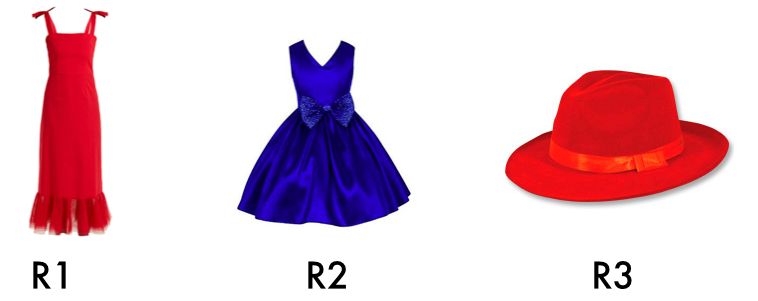-
Here is an observation that I talked about at MIT’s category theory seminar at some point, relating Grice’s maxims of Quantity and Quality to the mathematical notion of a Galois connection.
Abstract Summary:
For a state space W, the left adjoint of a monotone map (i.e. a left Galois connection), \(L_0\), from a set of utterances U to the poset (ordered by inclusion) \(\mathcal{P}(W)\) is the monotone map \(S_1: \mathcal{P}(W)\to U\) which takes a set of states and returns the strongest true utterance with respect to \(L_0\). This happens to be a very natural way to encode Grice’s maxims of Quality (roughly: speak truthfully) and Quantity (roughly: be as informative as possible, relative to what is relevant) simultaneously.
Concrete Explanation:
Each \(w \in W\) is a state of the world, or, so that each element of \(\mathcal{P}(W)\) is a set of states.
As usual, the simplest possible example is a reference game, where “state” just means the intended referent. Concretely, say that W = \(\{R_1, R_2, R_3\}\) as pictured below, and U = {red dress, dress, hat, silence}. Obviously arbitrary choices, but just for illustration.

Say that the literal listener \(L_0\) maps an utterance u to the set of referents (i.e. states, i.e. worlds) compatible with u, mapping red dress to \(\{R_1\}\), dress to \(\{R_1, R_2\}\) , hat to \(\{R_3\}\) and silence to \(\{R_1, R_2, R_3\}\).
Note that we can make U a poset by defining the partial ordering on U where \(u \leq u’ \leftrightarrow L_0(u) \leq L_0(u’)\). For example, \(\mathit{dress} \leq \mathit{silence}\). Note that \(u \leq u’\) means that u is stronger than u’.
It then follows (by the definition of the ordering on U) that \(L_0\) is a monotone map (i.e. a function that preserves the poset ordering) from U to W.
Galois Connections
So far just definitions. Just one more: for monotone maps f and g, f is the left Galois connection of g iff:
$$f(s) \leq u \leftrightarrow s \leq g(u)$$
It takes a bit of thinking to make sense of this strange definition, but the intuition is this: there’s no obvious notion of an exact inverse of g, because g might well not be surjective (or injective). But for a monotone map, there’s a notion of the best approximation of such an inverse. That approximation is f, as defined above. (In fact there are two, the left and right Galois connections, and more broadly, the left and right adjoints of a functor. A monotone map is a very simple case of a functor between very simple categories, namely posets).
Maybe this direct corollary of the above definition will help: if I know g, then its left adjoint f is defined as:
$$f(s) = \bigwedge(\{u : s \leq g(u)\})$$.
I write \(\bigwedge(X)\) for a poset X to mean the greatest lower bound of X.
OK, so now you can ask: what’s the left Galois connection of the literal listener \(L_0\)? Let’s call this left Galois connection \(S_1\), for reasons that will soon be clear. Again, note that \(L_0\) can’t just be inverted, because it’s in general not the case that for any subset s of W (i.e. element of \(\mathcal{P}(W)\)), there’s an expression which means exactly s under \(L_0\).
It’s illustrative to work through an example, to see what \(S_1\) looks like. Using our case from above, what’s \(S_1(\{R_2\})\)?
Well, \(S_1(\{R_2\}) = \bigwedge\{u : \{R_2\} \leq L_0(u)\})\) = \(\bigwedge(\{dress, silence\})\) = \(dress\).
First you find all the utterances that map to supersets of \(\{R_2\}\). These are all the true utterances (Quality). Then you take the greatest lower bound (Quantity).
So in other words, the definition of an left Galois connection gives you the following informative speaker \(S_1\): consider the set of all utterances compatible with your (possibly singleton) set of worlds, and choose the strongest of these. There’s something nice about how the maxims of Quality and Quantity fall out from this.
We also obtain similar results for pragmatic implicatures (that I won’t sketch out here for reasons of laziness) namely that a literal speaker, in the form of a monotone map \(S_0\) from w \(\in\) W to us in \(\mathcal{P}(U)\), admits a left Galois connection \(L_1\) which returns the exhaustification (linguistics term) of the literal meaning of us. So this would model, for example, the fact that the pragmatic interpretation of a (possibly singleton) set of utterances us should give the smallest set of possible worlds that could have produced every \(u \in \mathit{us}\).
The niceness of this correspondence between Galois connections and pragmatics suggests that something relatively deep is going on here, but I haven’t thought about it too much further. The sensible thing to do would be to consider the categorical generalization of Galois connections, namely adjoint functors, and to see if we get the same effect when we invert a more sophisticated functorial semantics.
I came up with this idea thanks to John Baez’s fantastic category theory course, based off of David Spivak and Brendan Fong’s Seven Sketches in Compositionality.
Summary:
*An informative speaker is a left Galois connection to a literal listener
*A pragmatic listener is a left Galois connection to a literal speaker